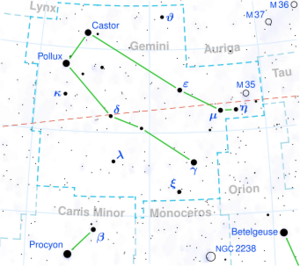Astronomy:Gliese 251
Coordinates: ![]() 06h 54m 48.96009s, +33° 16′ 05.4393″
06h 54m 48.96009s, +33° 16′ 05.4393″
| Observation data Equinox J2000.0]] (ICRS) | |
|---|---|
| Constellation | Gemini |
| Right ascension | 06h 54m 48.96009s[1] |
| Declination | +33° 16′ 05.4393″[1] |
| Apparent magnitude (V) | +10.11[2] |
| Characteristics | |
| Spectral type | M3.0Ve[3] |
| U−B color index | +1.20[4] |
| B−V color index | +1.60[4] |
| Astrometry | |
| Radial velocity (Rv) | 22.91[5] km/s |
| Proper motion (μ) | RA: -723.99[1] mas/yr Dec.: -398.40[1] mas/yr |
| Parallax (π) | 179.0629 ± 0.0280[6] mas |
| Distance | 18.215 ± 0.003 ly (5.5846 ± 0.0009 pc) |
| Absolute magnitude (MV) | 11.23[7] |
| Details | |
| Mass | 0.360±0.015[8] M☉ |
| Radius | 0.364±0.011[8] R☉ |
| Surface gravity (log g) | 4.96±0.07[8] cgs |
| Temperature | 3451±51[8] K |
| Metallicity [Fe/H] | -0.03±0.16[8] dex |
| Rotational velocity (v sin i) | ≤2[8] km/s |
| Other designations | |
| Database references | |
| SIMBAD | data |
| ARICNS | data |
Location of Gliese 251 in the constellation Gemini | |
Gliese 251, also known as HIP 33226 or HD 265866, is a star located about 18 light years away from the Solar System. Located in the constellation of Gemini, it is the nearest star in this constellation.[10] It is located near the boundary with Auriga, 49 arcminutes away from the bright star Theta Geminorum; due to its apparent magnitude of +9.89 it cannot be observed with the naked eye.[2] The closest star to Gliese 251 is QY Aurigae, which is located 3.5 light years away.[11]
Gliese 251 is a red dwarf with a spectral type of M3V[3] with an effective temperature of about 3300 K.[3] Its mass has been measured to be around 0.36 solar masses[8] and its radius is about 36% solar radii.[8] Its metallicity is likely slightly less than that of the Sun.[8] Observations at infrared wavelengths rule out the presence of a circumstellar disk around it.[12]
Planetary system
In 2019, two candidate planets were detected by the radial velocity method to orbit Gliese 251 at orbits of 1.74 and 607 days.[13] However, a new study in 2020 using CARMENES data refuted both candidates, as they found that both signals were caused by stellar activity. Based on the CARMENES data, the team announced that Gliese 251 is orbited by one single super-Earth (Gliese 251 b) at an orbit of 14.238 days.[8]
| Companion (in order from star) |
Mass | Semimajor axis (AU) |
Orbital period (days) |
Eccentricity | Inclination | Radius |
|---|---|---|---|---|---|---|
| b | ≥4.0±0.4 M⊕ | 0.0818+0.0011−0.0012 | 14.238±0.002 | 0.10+0.09 −0.07 |
— | — |
See also
- List of exoplanets discovered in 2020 - Gliese 251 b
References
- ↑ 1.0 1.1 1.2 1.3 van Leeuwen, F. (2007). "Validation of the new Hipparcos reduction". Astronomy and Astrophysics 474 (2): 653–664. doi:10.1051/0004-6361:20078357. Bibcode: 2007A&A...474..653V. http://www.aanda.org/index.php?option=com_article&access=bibcode&Itemid=129&bibcode=2007A%2526A...474..653VFUL.
- ↑ 2.0 2.1 Høg, E. (2000). "The Tycho-2 catalogue of the 2.5 million brightest stars". Astronomy and Astrophysics 355: L27–L30. Bibcode: 2000A&A...355L..27H.
- ↑ 3.0 3.1 3.2 Lépine, Sébastien (2013). "A Spectroscopic Catalog of the Brightest (J < 9) M Dwarfs in the Northern Sky". The Astronomical Journal 145 (4): 102. doi:10.1088/0004-6256/145/4/102. Bibcode: 2013AJ....145..102L.
- ↑ 4.0 4.1 Mermilliod, J.-C. (1986). "Compilation of Eggen's UBV data, transformed to UBV (unpublished)". Catalogue of Eggen's UBV Data. Bibcode: 1986EgUBV........0M. http://cdsads.u-strasbg.fr/cgi-bin/nph-bib_query?1986EgUBV........0M&db_key=AST&nosetcookie=1.
- ↑ Nidever, David L. (2013). "Radial Velocities for 889 Late-Type Stars". The Astrophysical Journal Supplement Series 141 (2): 503–522. doi:10.1086/340570. Bibcode: 2002ApJS..141..503N.
- ↑ Brown, A. G. A. (2021). "Gaia Early Data Release 3: Summary of the contents and survey properties". Astronomy & Astrophysics 649: A1. doi:10.1051/0004-6361/202039657. Bibcode: 2021A&A...649A...1G. Gaia EDR3 record for this source at VizieR.
- ↑ "ARICNS 4C00526". ARICNS. http://wwwadd.zah.uni-heidelberg.de/datenbanken/aricns/cnspages/4c00526.htm.
- ↑ 8.00 8.01 8.02 8.03 8.04 8.05 8.06 8.07 8.08 8.09 8.10 Stock, S. et al. (2020), "The CARMENES search for exoplanets around M dwarfs Three temperate-to-warm super-Earths", Astronomy & Astrophysics A112: 643, doi:10.1051/0004-6361/202038820, Bibcode: 2020A&A...643A.112S
- ↑ "GJ 251". SIMBAD. Centre de données astronomiques de Strasbourg. http://simbad.u-strasbg.fr/simbad/sim-basic?Ident=GJ+251.
- ↑ "Closest Stars". http://www.closeststars.com.
- ↑ "Stars within 15 light-years of Wolf 294". The Internet Stellar Database. http://www.stellar-database.com/Scripts/find_neighbors.exe?ID=44600&ly=15.
- ↑ Beichman, C. A. (2006). "New Debris Disks around Nearby Main-Sequence Stars: Impact on the Direct Detection of Planets". The Astrophysical Journal 652 (2): 1674–1693. doi:10.1086/508449. Bibcode: 2006ApJ...652.1674B.
- ↑ Barnes, J. R.; et al. (2019-06-11). "Frequency of planets orbiting M dwarfs in the Solar neighbourhood". arXiv:1906.04644 [astro-ph.EP].
Notes
 |


